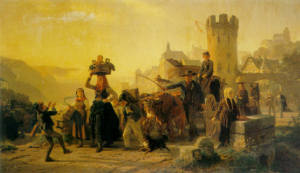Now we are well into September and in places where there are vineyards, the grapes are ripening on the vines, speaking of great alchemical potential: crushed and barreled and left to ferment, activating natural yeasts and sugars, the next wines are about to be made.
The timing of today’s feast––at the start of the grape harvest––is, to me at least, interesting. Nine months ago we celebrated the solemnity of the Immaculate Conception, and today, we celebrate the Nativity of Mary. The Church celebrates the deaths of saints (don’t you love when I tell you all those gruesome tales of how saints met their ends?) but in the case of Mary and John the Baptist, also their births. And tradition tells us that Mary was born on this day in Jerusalem to St. Ann and St. Joachim.
Italians like to eat blueberries for this day, a day important to all Marias and Mariettas… and there are many in my family. The blue of the berry is a reference to the traditional color of Mary’s cloak. Lights are illuminated in windows, especially in the rural areas, and bonfires are not uncommon on this night. Across the Alps, in Austria, it is time to bring the sheep and cattle down from the mountains and into the valleys: winter is fast approaching, and the Nativity of Mary on the 8th of September is known there as “Drive Down Day” in honor of this custom of moving the animals, often with some pomp and ceremony.
In France, though, there is this nice connection between the Nativity of Mary and wine: winemakers refer to the day as “Our Lady of the Grape Harvest,” bringing their best grapes to church for blessing. Across France you will find bunches of grapes placed in the hands of statues of Mary on this day. I like this connection between Mary, a goddess of sorts, and wine, especially as we ponder the bread and wine that is central to each church Mass, but central also to any good meal in places throughout Europe. These two elements can easily be a meal unto themselves (“a jug of wine, a loaf of bread, and thou”), should that be all you have, and you’d walk away sated and probably quite happy.
Image: Setting Out for the Grape Harvest by Christian Eduard Böttcher. Oil on canvas, 1867, [Public domain] via WikiMedia Commons.

Wine is good wit seltzer too. Try it . You’ll enjoy it.
Another lovely story, and I just came in from my grandparents’ garden with a handful of Concord grapes from the old vine! It is the only one left of my Grandpa’s small vineyard, since my Grandma had most of the garden torn out after his death. She simply couldn’t tend to it any longer. But the smell and taste of those few grapes brought back tons of fond memories of helping Grandpa in the garden in the Summers, drinking the juice before he made it into wine…
Yes, I would be quited sated with a loaf of bred and some wine. And quite happy.